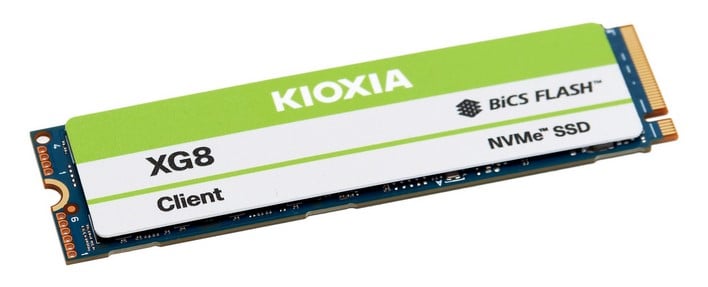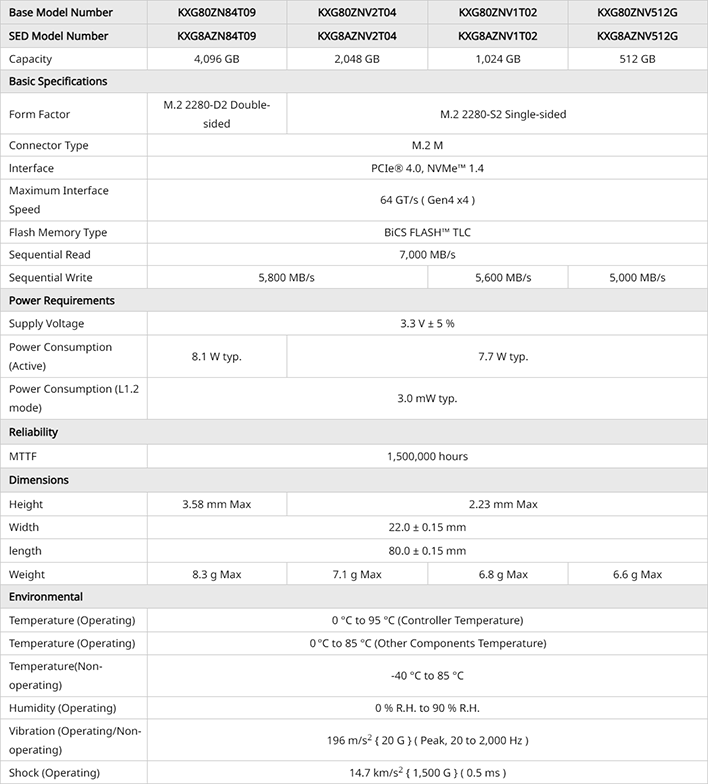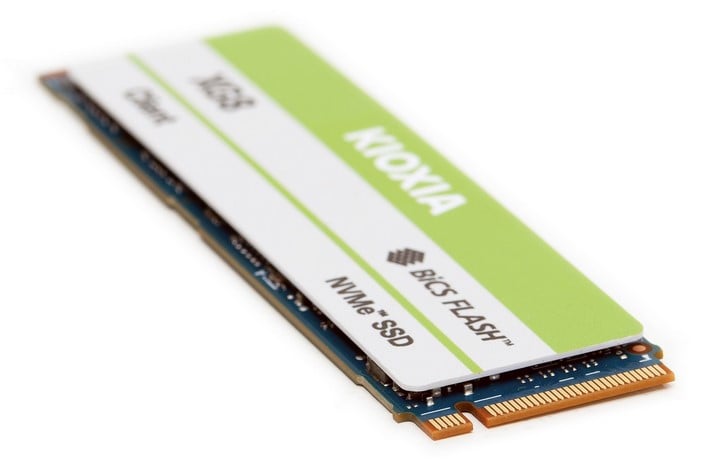Kioxia XG8 SSD Review: Fast PCIe 4 Storage For OEM PCs
Kioxia XG8: High-Performance NVMe Storage For System Builders
| Kioxia XG8: Starting at $59, $189 For 2TB A new NVMe controller and the latest 3D NAND combine to make a very solid product for OEM markets. It won't officially come to retail channels, though.
|
|||

|

|
||
Kioxia may not be a household name just yet, but there's a decent chance that your laptop has a Kioxia solid-state drive within. In fact, the Toshiba subsidiary's SSDs can be found in desktops, workstations, and even servers racked up in a datacenter as boot drives. That's exactly the target market for the company's latest high-performance SSD, the XG8, which Kioxia unveiled earlier this year.
The XG8 is focused on OEM channels, as opposed to being sold directly to consumers at retail, but that doesn't mean that it's hiding some hideous performance deficiency behind its integrator-only status. As you'll see below, the XG8 is a rather competitive drive that can keep up with other current midrange-focused PCIe 4.0 drives, but let's not get too far ahead of ourselves. First let's meet the Kioxia XG8...
Kioxia XG8 Specifications And Features
We're testing a 2 TB version of the XG8, which comes in the usual M.2 2280 form factor. It's offered in sizes from 512 GB all the way up to 4 TB, the latter requiring that flash memory occupies both sides of the drive. This NVMe SSD has all of its 5th-generation BiCS 3D NAND on one side, so no heat should be sandwiched between the motherboard and SSD. The controller supports PCI Express 4.0 with four lanes of connectivity, which has been the standard for enthusiast SSDs for quite a while now.
Kioxia compares the XG8 to the much older PCIe 3.1 XG6, which we reviewed as a retail drive from parent company Toshiba, but this isn't the company's first foray into PCIe 4.0 drives. For example, the XG7 can be found in Lenovo's ThinkPad P15, and it was a speedy drive as well. As far as the XG8 goes, Kioxia rates it for a blistering 7 GB per second in throughput for reads and 5.8 GB/sec in writes and would easily eclipse what the XG7 did as part of the ThinkPad. Regardless of comparison points, the XG8 promises to be a big upgrade.
Kioxia says the XG8 should be good for upwards of 900k I/O operations per second for random reads and 600k IOPS for writes. Benchmarks that rely on the file system rarely ever see those stratospheric ratings, but the hardware for low-latency reads and writes seems to be present, at least.
The XG8 is outfitted with Toshiba's latest 5th-generation BiCS flash memory, which has 112 layers of 3-bit-per-cell (TLC) memory. This should allow for higher capacities and lower latencies than the previous generation
The back of the XG8, like several other drives including Samsung's SSD 990 Pro, has nothing but a thermal coating and some traces. Since the 4 TB version of the XG8 has NAND on both sides, heat that could otherwise have nowhere to go should be somewhat more manageable under pressure. Combined with NVMe's host-controlled thermal management, we expect that the drive will perform as well as possible for as long as physics allow under sustained workloads.
Along with new hardware, the XG8 also supports some new features, including NVMe version 1.4 which supports direct host memory buffer access, new power states, and host-controlled thermal management. There's also power loss notification to protect data against forced shutdowns, and optional security features in the form of the Trusted Computing Group's Pyrite and Opal v2.01 specs for self-encryption.
Now that we've had a tour of the Kioxia XG8, let's take a look at how it performs in an array of tests.
Kioxia XG8 PCIe Gen 4 SSD Benchmarks
Under each test condition, the SSDs showcased here were installed as secondary volumes in our testbed, with a separate drive used for the OS and benchmark installations. Our testbed's motherboard was updated with the latest BIOS available at the time of publication and Windows 11 was fully updated. Windows firewall, automatic updates, and screen savers were all disabled before testing and Focus Assist was enabled to prevent any interruptions.
In all test runs, we rebooted the system, ensured all temp and prefetch data was purged, and waited several minutes for drive activity to settle and for the system to reach an idle state before invoking a test. All of the drives here have also been updated to their latest firmware as of press time. Where applicable, we would also typically use any proprietary NVMe drivers available from a given manufacturer, but all of the drives featured here used the Microsoft driver included with Windows 11.HotHardware's Test System:
| Processor: AMD Ryzen 9 7950X Motherboard: Asus ROG CrossHair X670E Hero Video Card: GeForce RTX 3080 Memory: 32GB G.SKILL DDR5-5200 Storage: ADATA XPG GAMMIX S70 Blade (OS Drive) ADATA XPG GAMMIX S50 Lite (1TB) Samsung SSD 980 Pro (2TB) Solidigm P41 Plus (1TB + 2TB) WD SN770 (1TB) Kioxia XG8 (2TB) |
OS: Windows 11 Pro x64 Chipset Drivers: AMD v3.10.22.706 Benchmarks: IOMeter 1.1 HD Tune v5.75 ATTO v4.01.01f AS SSD SiSoftware SANDRA CrystalDiskMark v8.0.4 x64 Final Fantasy XIV: Endwalker PCMark 10 Quick Storage Bench 3DMark Storage Tests |
IOMeter Benchmarks
IOMeter is a well-respected industry standard benchmark. However, despite our results with IOMeter scaling as expected, it is debatable as to whether or not certain access patterns actually provide a valid example of real-world performance. The access patterns we tested may not reflect your particular workloads, for example. That said, we do think IOMeter is a reliable gauge for relative throughput, latency, and bandwidth with a given storage solution. In addition, there are certain highly-strenuous workloads you can place on a drive with IOMeter, that you can't with most other storage benchmark tools.In the following tables, we're showing two sets of access patterns; a custom Workstation pattern, with an 8K transfer size, consisting of 80% reads (20% writes) and 80% random (20% sequential) access and a 4K access pattern with a 4K transfer size, comprised of 67% reads (33% writes) and 100% random access. Queue depths from 1 to 16 were tested...
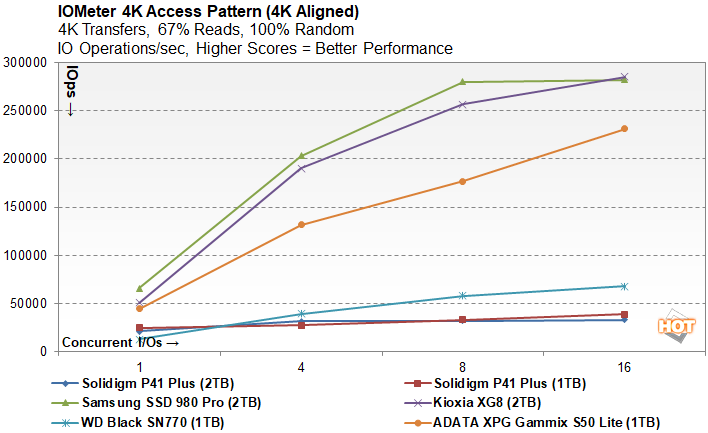
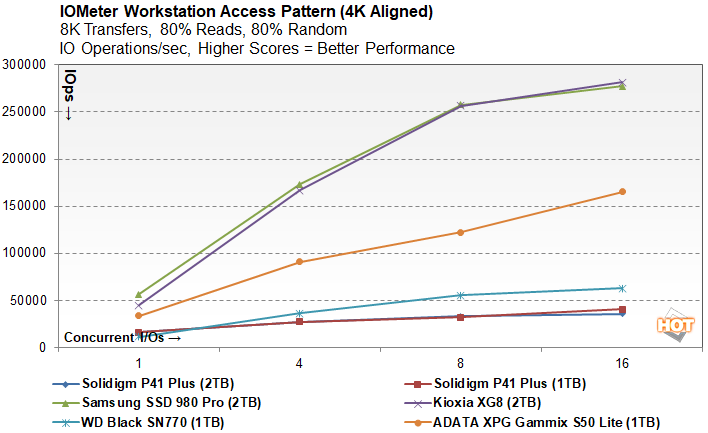
The Kioxia drive's random I/O performance is very good, running nearly neck and neck with the Samsung SSD 980 Pro and far ahead of every other drive once we get into more concurrent operations. Scaling is almost perfectly 1:1 when moving from one to four operations at a time, with more to gain at eight and 16. These workloads are vastly different, and the second test which reduces randomness from 100% to 80% (meaning, more sequential operations) and increases the ratio of reads from 3:1 to 4:1, the XG8 could take a lead.

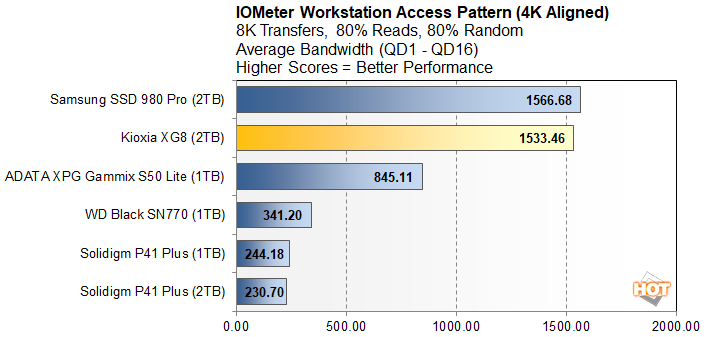
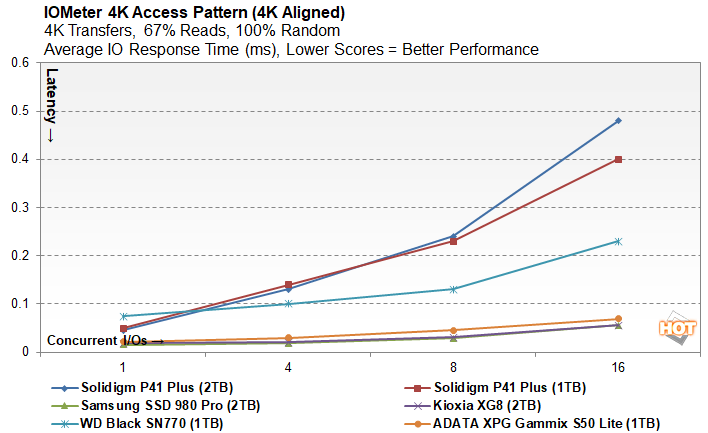
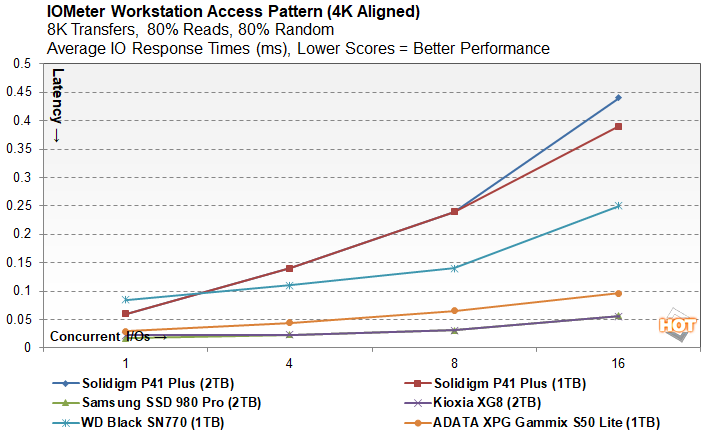
Our latency results mirror our I/O charts, which only makes sense. If the drive exhibits lower latency, it is completing operations faster. Just like the throughput tests, the Samsung and Kioxia drives run neck-and-neck for the entirety of both runs.
SiSoft SANDRA 2021
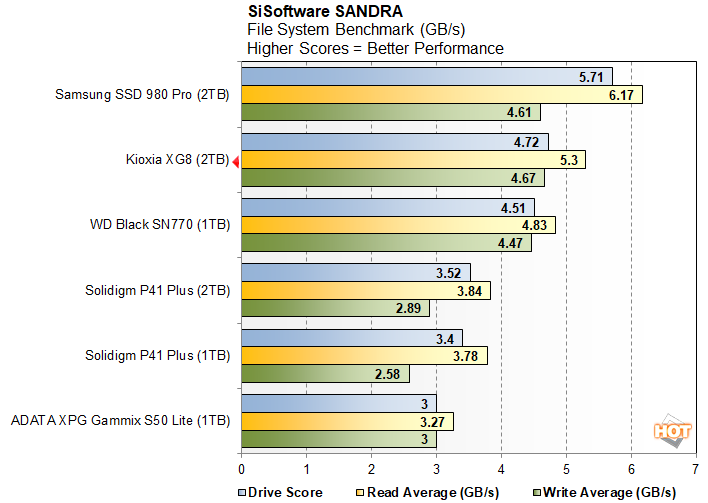
In SANDRA's file system benchmark, we take some of the abstraction away since the application doesn't have direct access to the hardware, and instead does its work through Windows to an NTFS volume, just like basically every client application. The bottom half of our chart has shuffled around quite a bit, but once again the XG8 comes in second to the Samsung SSD 980 Pro. A read average of 5.3 GB per second is still quite respectable, as is the greater than 4.7 GB per second in writes. This time, the WD Black SN770 gets the bronze medal, and it's quite a bit closer than the IOMeter results. In reality, none of these drives would feel slow, but Kioxia has a 50% advantage over the bottom of the pack while trailing the leader by just a smidge.
ATTO Disk Benchmark
ATTO is another "quick and dirty" type of disk benchmark that measures transfer speeds across a specific volume length. It measures raw transfer rates for both reads and writes and graphs them out in an easily interpreted chart. We chose .5KB through 64MB transfer sizes and a queue depth of 6 over a total max volume length of 256MB. ATTO's workloads are sequential in nature and measure raw bandwidth, rather than I/O response time, access latency, etc.
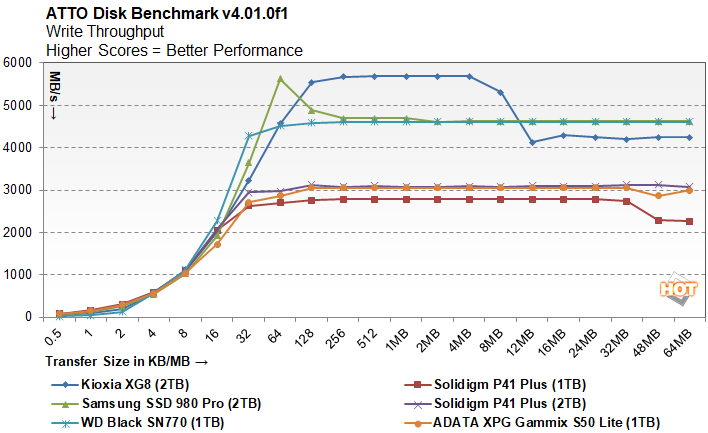
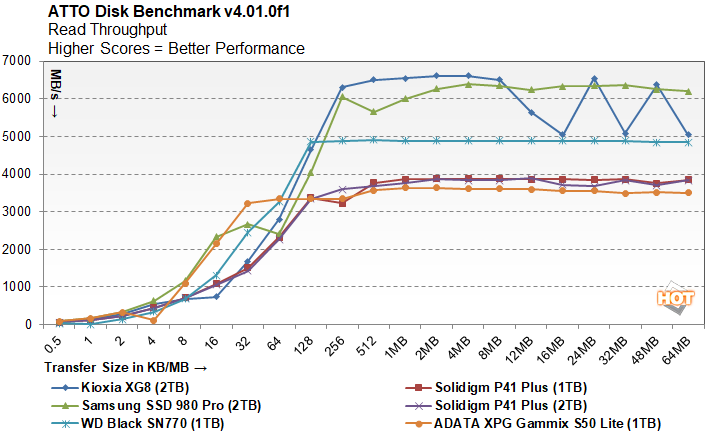
The XG8 had some really interesting behavior in ATTO's read and write throughput tests. It doesn't quite max out the speed as quickly as Samsung's SSD 980 Pro but it also drops off considerably once it hits the 12 MB mark. This probably means that the drive has exhausted its SLC write cache and we're seeing the true write performance of Kioxia's Gen 5 BiCS flash memory. Even if that's the case, it lasts a lot longer at higher write speeds than the 980 Pro, which peaks early and drops off quickly, and puts all other challengers in the rear view mirror quickly.
That does not, however, explain the odd behavior in the read test. We're not clear as to why it produced the saw-tooth pattern with the larger transfer sizes, but it's good to remember that we run these tests multiple times, so this isn't a fluke. Regardless, the valleys on display here are still faster than the sustained performance of the WD Black SN770, while the Solidigm P41 Plus drives and the ADATA XPG Gammix S50 Lite are all about 20% slower still. The XG8 acquits itself nicely, all things considered.

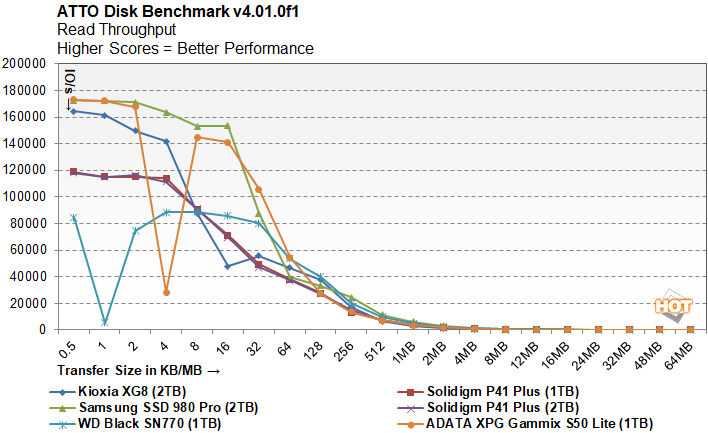
IO performance for writes starts off slowly, but jumps up to the rest of the pack quickly, and by the time we hit the file system's 4 KB block size, it's right in line with every other drive. The WD Black SN770 and Samsung 980 Pro both trail off more slowly, than the Kioxia, but the XG8 still beats out the rest of the pack all the way up to 64 MB block sizes. Writes are consistently good from the start early on but drop off at 8 and 16 KB, which is earlier than most of the other drives. Overall it's by no means slow, but definitely not exhibiting the consistent top-end I/O throughput we saw earlier.
AS SSD Compression Benchmark
Next up we ran the Compression Benchmark built-into AS SSD, an SSD specific benchmark being developed by Alex Intelligent Software. This test is interesting because it uses a mix of compressible and non-compressible data and outputs both Read and Write throughput of the drive. We only graphed a small fraction of the data (1% compressible, 50% compressible, and 100% compressible), but the trend is representative of the benchmark’s complete results.

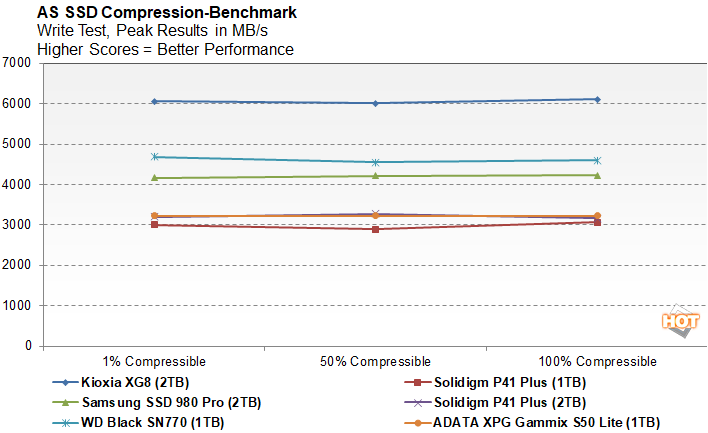
On the next page we're going to continue our onslaught of tests moving from the synthetic to the real world, and then sum up our thoughts on this (so far) impressive OEM-focused drive.

